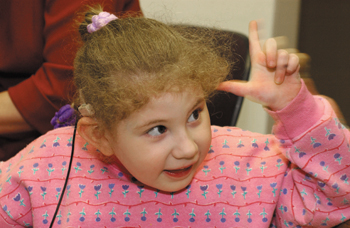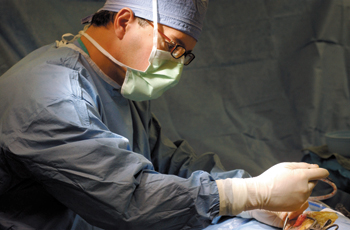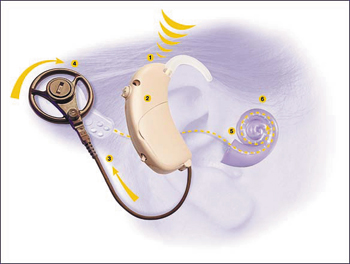
"Listen," Nikki Langston signs. Audiologist Andrea Hedley-Williams is sending the first sounds, a series of beeps, to Nikki’s cochlear implant on Feb. 21. It’s the first sound the girl has ever heard. (photo by Neil Brake)
Sound care — Cochlear implant team spans research, surgery, therapy and education


Dr. David Haynes implants 20-30 cochlear implants a year, in Middle Tennessee, and expects to increase the volume to 40-50. The cochlear implant team includes surgeons, researchers, educators and therapists, and is one of few in the country approved to test bilateral implants. (photo by Dana Johnson)

How cochlear implants work: 1. Sound is received by the microphone. 2. The sound is analyzed and digitized into coded signals by an internal chip. 3. Coded signals are sent to the transmitter. 4. The transmitter sends the code across the skin to the receiver where it is converted to electronic signals. 5. Signals are sent to the electrode array in the cochlea to stimulate the hearing fibers. 6. Signals travel to the brain where they are recognized as sounds, producing a hearing sensation. (courtesy Cochlear Corp.)
A baby’s crying in the hallway outside the room where 6-year-old Nikki Langston will soon have her cochlear implant turned on for the first time. Born with a sensorineural hearing loss, the girl’s world doesn’t include sound. She can’t know there’s a baby close by, or that it’s wailing.
Nikki’s cousin catches her attention and signs baby, cradling his arms, then crying by running his fingers down his face. Nikki’s eyes stretch wide, with an expression of, “Really?”
The implant has 24 electrode contacts paired on 12 “channels” on an electrode coiled around the tiny cochlea deep inside her ear that produce tones across a frequency range of 125 to 4,500 Hertz, representing most speech (around 250 Hertz) and environmental sounds. Audiologist Andrea Hedley-Williams has the device’s speech processor, which fits around Nikki’s ear, tethered to a computer. She activates each channel with a keystroke, adjusts the volume and sends a single beep to the implant as a test. For a long while, there’s nothing. Nikki either doesn’t hear the sound or doesn’t respond to it, and she plays with a Mr. Potato Head, sticking an ear where his nose should be.
Then, on channel No. 1, with the volume turned up high, Nikki hears it. She turns her head toward Hedley-Williams and the computer, her mouth agape. She hears another beep on channel 4. For the first time in her life, the short and long hairs inside the tiny cochlea have stirred and awakened the auditory nerve. Her brain has detected sound. She turns to her cousin, wanting to associate the beep with the first thing that comes to mind. With her eyes wide she signs, “baby cry.”
Nikki’s universe just expanded. A portal to a new sensation just opened, and her journey into it just began.
It has been a month since Dr. David Haynes implanted the device, a signal transmitter imbedded in the temporal bone behind her right ear from which the electrode is threaded into the coil of cochlea. It will be many more long months before she has sound-object recognition, hearing a ring and knowing it’s the telephone, or a bark and knowing it’s a dog. And it will be years, probably, until she learns the most difficult task of generating her own sounds into comprehensible words and sentences.
Bridge across departments
Nikki’s cochlear implant represents the widest bridge between the departments of Otolaryngology and Hearing and Speech Sciences in the Vanderbilt Bill Wilkerson Center for Otolaryngology and Communication Sciences. The physicians, scientists and researchers in the cochlear implant program work more closely than in any other. “We need them and they need us,” says Haynes, associate professor of both of the Center’s departments and director of neuro-otology.
The new home for the Center going up now will only shorten that bridge, making collaborations easier.
“We have developed into a major cochlear implant center that will be distinguished as a department of excellence regionally and nationally,” says Dr. Robert Ossoff, director of the Center and chair of Otolaryngology.
Haynes has been on board since 1996 and is responsible for the majority of cochlear implants in Middle Tennessee since then, doing 20 to 30 a year and expecting to increase that volume to 40 to 50.
Last year, Dr. Robert Labadie, with a medical degree and a doctoral degree in bioengineering, was added as assistant professor of Otolaryngology to increase the research component of the program and help expand the base of adult patients. Among his studies: whether hair cells that stimulate sound can be regenerated, whether people benefit more with bilateral implants, and the benefits of giving older people cochlear implants.
Vanderbilt is also one of a small handful of sites approved by the Food and Drug Administration for clinical trials of bilateral implantation, putting cochlear implants in both ears. The trauma of surgery to both ears was thought to outweigh the benefit of bilateral implants; Vanderbilt’s team will help resolve the issue.
The depth in Otolaryngology dovetails with well-established components in Hearing and Speech Sciences: Assistant professor Todd Rickets is a leader in hearing aid studies; Troy Hackett, research assistant professor, works on the basic understanding of speech processing; Anne Marie Tharpe, associate professor, adds an educational angle, teaching graduate students; and the cochlear implant team, composed of audiologists, speech-language pathologists and coordinator Kristy Adamski, brings decades of experience to helping teach children how to hear and speak, led by Geneine Snell.
All of this combined offers what no other center in the nation can, or has tried to, Ossoff says. “We didn’t want to be a niche player on the fringe, but instead we chose the area (in otolaryngology) where every other department in the country just wasn’t developed.”
Loss of hearing shakes up an entire developmental process. Not only is life void of sound, but it’s missing cues from the environment used to learn, from words to warnings to the production of speech and language. Research says most of this happens by age 7, says Snell, a speech pathologist and leader of the Aural Habilitation Team. That learning, she says, “is what hearing-impaired children are not able to do for themselves.”
Normal hearing involves signal transduction, turning auditory energy into neural energy, with the cochlea’s short and long hair cells, both microscopic, vibrating in a bath of natural fluid to stimulate the auditory nerve. In someone with sensorineural hearing loss, like Nikki’s, the hair cells are frozen.
An implant has an earpiece with a microphone that picks up sound and an internal chip that analyzes and digitizes it, and sends sound to a transmitter, which sits fixed by a magnet to the metal receiver imbedded just under the skin. The transmitter sends a signal to the receiver, and the receiver stimulates the electrode array in the cochlea, which stimulate the auditory nerve. What the brain “hears” and the person perceives is an electrical or mechanical sound. Voice may sound high-pitched or tinny.
The sooner a child’s hearing can be restored, the less interruption there is to the learning process, Snell says. Haynes recently installed an implant in a 1-year-old girl whose hearing loss was detected in the hospital the day after she was born.
Another theory suggests early implantation could stimulate the hair cells into working and re-establish the neural pathway, Labadie says. Haynes says molecular genetics might also hold the key to future curatives, using steroids and other medications to stimulate the growth of nerve cells.
Currently, cochlear implants are warranted only when someone has no benefit from hearing aids. But many people get caught in a debate, usually between insurance companies and physicians, of whether someone is a good candidate. “There’s a difference between predicting a good candidate and predicting good performance,” Haynes says. It’s relative; while no one, at least not yet, will be able to hear normally, they will hear better with implants.
But while debates about children wage, adults are often forgotten, as Labadie’s work in adults highlights. He has applied for NIH funding to help determine the need and value of cochlear implants in adults. “Is there an age at which we should not implant adults?” Labadie says. “More importantly, is it worth the money? We believe it is.”
According to an NIH paper, people 65 years and older make up 12 percent of the U.S. population. About three million of them have hearing aids, Labadie says, while more than a quarter million are candidates for cochlear implants—and about 5,000 have them.
Especially in older people, hearing loss can lead to other health problems or unhealthy lifestyles, including depression, isolation and a general decline in well being. “If you can’t hear, when you walk into a room you can’t participate,” Labadie says. “Many adults think it’s part of life. There are a lot of lonely people in the U.S.; it truly is an epidemic.”
There’s a perception, Labadie says, that older people will not tolerate implants, or that they can’t adapt to the mechanical, electrical sound. But, he says, “it’s related to the decreased value of older adults.” And, when insurers balk on payments, “it puts a dollar value on rehabilitating older adults.”
Fred Lawrence, 64, from Kingsport, Tenn., supports that argument. He had worn hearing aids since the ‘70s. Five years ago, his hearing was down to about 30 percent. “Last year it was down to nothing,” he says.
In October, he received a cochlear implant by Haynes. In February, audiologist Susan Amberg was making some adjustments to the device, improving the range of sounds. It’s not only allowed him to hear things he didn’t before, like the little warning buzzers in his car, it’s made a difference “between hearing and understanding,” he says. He can go into a store, ask a question and understand the answer. “Living in the world’s a lot more pleasant,” he says.
Nikki’s hearing
The day of her surgery, Tammy Briley, Nikki’s aunt who has legal custody of the girl, said, “Anything that’s going to help her communicate better, I’m going to do it.”
If Nikki could hear and speak, she would be the one in class sent most often to time out for talking too much. She’s typical of most 6-year-old girls, eager to show off fresh pink nail polish and a flowery dress. She’s precocious, thirsty for challenge. She quickly learned the alphabet and the signs for the letters, she’s always asking questions and she’s always pushing the bounds of behavior, learning as she does.
When Nikki was 9 months old her mother noticed she wasn’t responding to sounds, Briley says. Nikki was fitted with hearing aids, but they never helped, and she learned her own frustrating form of communicating, squealing and screaming to get what she wanted. “She tries so hard to talk,” Briley says.
An audiologist told Briley about the implant. She had seen Haynes on a TV news segment, and last February she called for an appointment. Last summer, Nikki started deaf education classes in Hearing and Speech Sciences, making the 90-mile round trip from their home in Portland, Tenn., because there wasn’t a deaf educator there. She learned how to sign and began preparation for an implant and, Briley says, her behavior improved immediately.
Eventually, if everything goes well, Nikki will have the equivalency of a mild hearing loss, Hedley-Williams says.
But on that first day, when Nikki heard for the first time, she reacted like most children do—she became frightened, Hedley-Williams says. “Initially, sounds can be very overwhelming,” she says.
Many of those new sensations were scary. “Everything’s a monster” to her, Briley says. “She started crying when she heard the washing machine.”
After the surgery, and while the appropriate patterns of volume and pitch on the implant are gradually adjusted, or “mapped,” the toughest part of the process is teaching Nikki what to do with it.
The first goal of therapy is “helping her make sense of the auditory information coming in,” says Snell. Nikki is proud of her implant, she hates taking off the earpiece. Most noises she hears now are the low-pitched ones. In class, she still doesn’t respond to speech and she signs most words, although Briley says Nikki can say “help,” “stop” and “baby.”
Snell, deaf educator Megan Morrison, Hedley-Williams and speech pathologist Misty Wright team to teach Nikki what sounds mean. Sound detection leads to identification—learning that quacks come from ducks, and that the roar in the sky is an airplane. “In time, sounds become meaningful to them,” Snell says. The next step is discriminating sound patterns, short vs. long sounds, “butterfly” vs. “ball,” and then the word and letter sounds, “ball” vs. “salamander.”
As Nikki learns the sounds, and comprehends their meaning, she’ll learn to produce them, with help articulating, learning to generate sound with a nasal resonance and open her mouth wider to make round vowel sounds.
“It’s not an overnight process. It takes years and years of auditory training,” Snell says. “But the progress we see (in Nikki) now isn’t even a tenth of what we’ll see five years from now.”
Meanwhile, Nikki continues to hear new things. It’s been a difficult ride, Briley says, frustrating and challenging, not only for Nikki but for her family, trying to mold their behavior to hers. But, it’s worth it, the aunt says. Nikki used to dance to music when she saw other kids dancing on TV. Now, Briley says, she dances when the radio is on, to the beat she might feel, but one she now also hears.













